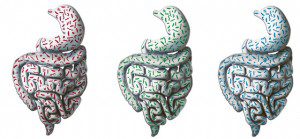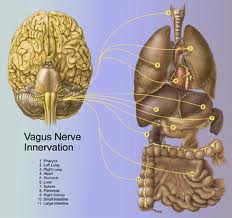
So far, there are 3 Enterotypes, each one leading to very different guts
By now you know that Kombucha is a probiotic, meaning it does the job of repopulating the gut with healthy bacteria and yeast.
In today’s world where the war on bacteria has been raging for decades, that can serve a critical function.
As mentioned in the Top 5 Ways Kombucha is Earth Friendly post, science is just now beginning to explore and understand the incredible importance of the human microbiome and discovering how bacteria function within our internal ecosystem. In case you missed it, the “Microbiome” is a mass of good bacteria in our guts that appears to have incredible power over our bodies.
A recent discovery has caused quite a stir in these circles. I will admit to being incredibly excited by the possibilities for deeper understanding of our bodies.
Scientists belonging to the Metagenomics of the Human Intestinal Tract (MetaHIT) Consortium led by Peer Bork have discovered that human gut microbiomes can be classified into 3 distinct types called “Enterotypes.”
Let’s find out how this important discovery will revolutionize medicine in much the same way that the discovery of different blood types did at the turn of the 20th century.
What’s Your Type?

Karl Landsteiner saved many lives when he discovered the different blood types.
“I’m an A-, how about you?” These days we take for granted that there are different blood types. However, this vital clue to understanding human health was not uncovered until the turn of the 20th century (1901) by Austrian biologist and physician Karl Landsteiner.
Prior to the discovery of the different blood types, biologists struggled to understand why blood transfusions worked for some patients yet proved fatal for others. There are now over 600 specific blood-group types that have been identified, many of which are unique to certain ethnicities.
Most people fall into one of four main types – A, B, AB and O – and, most importantly, they are not all compatible with each other. Landsteiner’s work (he also discovered the polio virus) had such a profound influence on our understanding of human physiology and modern medicine that in 1930 he won the Nobel Peace Prize.
If the discovery of blood type catapulted medicine into the 20th century, just imagine how far advancements in understanding enterotype can take us!
I’ll go into more detail about enterotypes, but first, did you know that your body has 2 brains?
Two Brains are Better Than One
Yep, that’s right. And you thought the brain in your head was doing the work? Actually there is a brain inside your gut too called the enteric nervous system.
Comprised of neurons, neurotransmitters and proteins housed in the tissue of the entire digestive tract from esophagus to colon, your Enteric Brain functions just like the brain in your head in that it carries out complex processes and is capable of learning, able to remember and of course, emits gut instincts.
These two brains are created from the same tissue in a developing fetus and evolve separately. They are later connected via the vagus nerve that runs all the way from the brain to the lower intestine. This same nerve also controls heart rate, sweating and speech.
When the mind feels nervous, that feeling travels down the vagus nerve causing the heart rate to increase, palms to sweat, “butterflies” in your stomach and can even affect speech, causing a nervous stammer.
Of course it makes sense: the brain in your head and the brain in your belly are connected! Of course the foods you eat have an impact on your emotions! Of course IBS is a physical manifestation of mental or emotional stress because EVERYTHING is connected in our physiology! Even food allergies and autism have been tied to the relationship between the neurological and gastrointestinal systems.
Understanding this relationship can drastically change our approach to resolving these ailments whether through individualized diet plans or healing treatments.
Know Guts, Know Glory
As we begin to understand the microbiome, the implications for human health could not be greater.
The field of neurogasteroenterology (say that 5 times fast) is still in its nascent stages, but according to the research that was just published, they have identified 3 main types or clusters of bacteria. While there is much to be discovered and explored about the enterotypes (remember that the brain in the gut is known as the enteric system), here is what the study was able to demonstrate.
Although the current understanding leaves them less clearly defined than the human blood groups, Enterotypes are stable and can be used to characterize individuals. “Each of these three enterotypes are identifiable by the variation in the levels of one of three genera (type of bacteria present): Bacteroides (enterotype 1), Prevotella (enterotype 2) and Ruminococcus (enterotype 3),” says the study.
Enterotypes use different means to generate energy from the food sources consumed. They are highly specialized and not only convert complex carbohydrates and proteins into an assimilable format but also aid in the synthesis of vitamins from the food we eat.

Bacteroides are among the most common bacteria found in the gut.
Basically, your enterotype not only indicates which type of diet is most beneficial to your specific physiology but also identifies which vitamins your gut is able to process most efficiently. Moreover, it means that there isn’t a one-size-fits-all dietary plan that makes sense for all people.
Here are some details about each enterotype. I scoured the Internet for information on these different types of bacteria but since this is cutting edge science, it proved difficult to ascertain clear distinctions as to which types of food are more easily utilized by which enterotype. While there are already three known nutritional types (carbs & vegetables, protein, & mixed), it is still unknown as to which will correspond to the types listed below.
Enterotype 1 – Bacteroides dominant
For the Bacteroides Dominant Enterotype, energy is primarily derived from carbohydrates and proteins. This type is also more effective at synthesizing biotin B7, riboflavin B2, pantothenate B5 and ascorbate Vitamin C.
According to Wikipedia: “They (Bacteroides) can use simple sugars when available, but the main source of energy ispolysaccharides from plant sources. Bacteroides species also benefit their host by excluding potential pathogens from colonizing the gut.”
This would seem to favor a more plant based diet works best for this type.

Prevotella melaninogenica is a part of the normal flora of the vagina, GI tract, and mouth.
Enterotype 2 – Prevotella dominant
The Prevotella sp. Dominant Enterotype is best at synthesizing and thiamine B1 and folic acid B9.
The Kenyon Microbewiki says, “This bacteria is among the most numerous microbes culturable from the rumen and hind gut of cattle and sheep, where they help the breakdown of protein and carbohydrate foods. They are also present in humans.”
Okay, I know, that sounds just like type 1 but Prevotella are a type of Bacteroide so it makes sense that they perform a similar function.
Further research will clarify the functional difference between the two types.
Enterotype 3 – Ruminococcus dominant
According to the samples studied, enterotype 3 occurred with the highest frequency.
Again the Kenyon Microbewiki explains, “Ruminococcus inhabits the rumen of cattle, sheep, and goats. These organisms allow their hosts to digest cellulose.” Cellulose is often referred to as roughage or dietary fiber in terms of humans. With all these bacteria in common with ruminants, perhaps we really are meant to graze.
These enterotypes were not found to have any correlation with gender, ethnicity, BMI (body mass index) or age. However, there are genes and other modules that do correlate and could be used as a diagnostic or prognostic tool to determine susceptibility for diabetes, colorectal cancer and other metabolic disorders.
Reconnect to Your Gut with Kombucha
So, how does Kombucha figure into the equation? All fermented foods (sauerkraut, miso and kefir to name a few) provide healthy bacteria to rebalance your enteric system. But Kombucha is one of the most versatile fermented foods of all. It can be drunk at any time of the day and can be flavored as wild or mild as the imagination enjoys. Not only that, but it alkalizes the body.
The rebalancing effect of regular Kombucha consumption has allowed me to reconnect to my gut feelings. Too much sugar makes my tummy hurt, just like it did when I was little. I don’t crave alcohol (only mentally, though I do have a glass from time to time in moderation) and I can feel when I’m full or when a food makes me feel gross. Its an old habit, but I’ll have a Coke now and then and I can taste the disgusting chemicals and high fructose corn syrup and end up pouring the rest down the drain. I am plugged back into what nutrition feels like so now my body is better able to recognize it.

Kombucha on ice – perfect for summer!
Try this experiment at home:
- Drink 4 oz of Kombucha on an empty stomach first thing in the morning. I recommend adding it to a large glass of water or drinking water immediately afterward.
- Listen to your body. Notice how the Kombucha feels on the inside.
- When you are ready to eat, have whatever you like.
- Again, notice how your body feels. Bringing mindful attention to the signals your other brain is sending will reconnect you to your gut feelings.
Some other ways to protect your enteric system:
- Avoid drinking chlorinated water
- Consume whole, unprocessed foods
- Remove toxic cleaners and beauty products from your home

Karen
February 19, 2014 at 9:59 amGreat summary and introduction to the nascent stages of this area of research. I’m looking forward to learning more as the info becomes available.
As for kombucha, I’ve been drinking store-bought KT for several months and am awaiting, VERY patiently, to tap into my first brew (only 4 more days to the first peek and taste test, yay!). I drink about 12-16oz over the course of the day. My stomach is less bloated, it feels cleaner (hard to explain this), and if I drink about 5 oz before bed, I sleep better -I wonder if the latter is due to the alcohol content.
The best effect is not physical, rather social emotional! My husband has begun to share my interest and is excited about home brewing, and when I’m in the stores buying KT, I just start chit chatting with others about KT. I’ve met some really nice people!
Thanks Hanna for sharing your knowlededge In a very Digestable (pun intended) manner.
Sarah
May 16, 2012 at 3:54 pmI have been drinking kombucha for a couple of months now and I am addicted. It is like drinking liquid happiness. It makes me feel so good. My toddler twins love it too and I have been giving it to my friends too. Share the love!
Caitlin Dean via Facebook
May 16, 2012 at 1:34 pmYes! Great stuff!
hellaD
June 6, 2011 at 11:21 pmGreat article! Very interesting about these different body types…I wonder if this relates to the Ayurvedic system … hummm…
hannah
June 7, 2011 at 11:48 pmThat is an excellent suggestion as a topic for exploration – I also want to research where it fits into TCM and other traditional healing systems.
Big hugs to Canada!! xxoo
Mark Wisecarver
June 6, 2011 at 3:43 pmLove this post. I drink a full glass each morning with a small hit of OJ in it, (after I finish my Espresso and then some water).
A few hours later I drink a glass of Kefir with ACAI blended in. btw, I’m 50 and still run 8k in under 30 minutes. 😉
hannah
June 6, 2011 at 11:17 pmYou are turbo charged Mark! Love to hear how you are livin life =)
hannah
June 4, 2011 at 12:12 pmYay! I’m so glad that the booch is working for you Annie =) Whenever you find the flavor of your KT too intense, try diluting it in water – it mellows the flavor but you still get all of the health benefits.
annie
June 1, 2011 at 5:34 pmi have been drinking booch now for a handful of yrs..(5) and the reason i started is becuase i kept getting sick over and over and over.. it was mostly viral and my body was just not doings its job anymore at keeping me ickyness free.. i have to say the first few months were tricky, i had to plug my nose and chug.. but now i dont even care if its gone sour or vinegary.. i have been doing my own from hannah since dec and its a tricky thing.. but even the bad batches are still not that bad. but when u nail it just right.. wow… fresh booch is killer.. even warm.. i tell my friends its an acquired taste.. most people think its weird when i tell them but it changed my life.. thanks hannah for all your help…
annie d
Echo
June 1, 2011 at 3:50 pmGreat article, Hannah. Lots of good info.
Since we’ve been advised that city tap water is safer and monitored better than the spring water we buy and the plastic bottles it comes in is only designed for 1 use, I boil my tap water and keep it in glass bottles. I realized it doesn’t make sense to drink chlorinated water with Kombucha. Any comments on that?
hannah
June 2, 2011 at 10:11 amYou are absolutely right Echo. Drinking chlorinated water is counter productive to gut health. Sounds like you’ve got the right idea with making it in advance and storing it in glass!
Eliana
June 1, 2011 at 1:20 pmSo this is interesting stuff….but where is the application? Kombucha is great. But as for the rest, where is there any info on finding out your “type”?
hannah
June 2, 2011 at 11:09 pmEnterotyping is just now being understood, so there isn’t too much information about the specific types and what they correlate to in terms of diet.
I’m going to find a lab that analysis (it requires a stool sample) – I’ll let you know the details when I find one. Although it may not be able to tell me my enterotype, it should be able to give me an idea as to what type of bacteria are present in my gut.
Denise Smith Maddox via Facebook
June 1, 2011 at 11:55 amThanks
Angie Morey
June 1, 2011 at 11:53 amSo interesting! And makes a lot of sense, too, that distinct enterotypes exist in our guts, just like blood types. I’ll look forward to reading more. Thanks so much for sharing!
Suzan Macco via Facebook
June 1, 2011 at 11:36 amEXcellent post… Very nicely done Hannah! 🙂